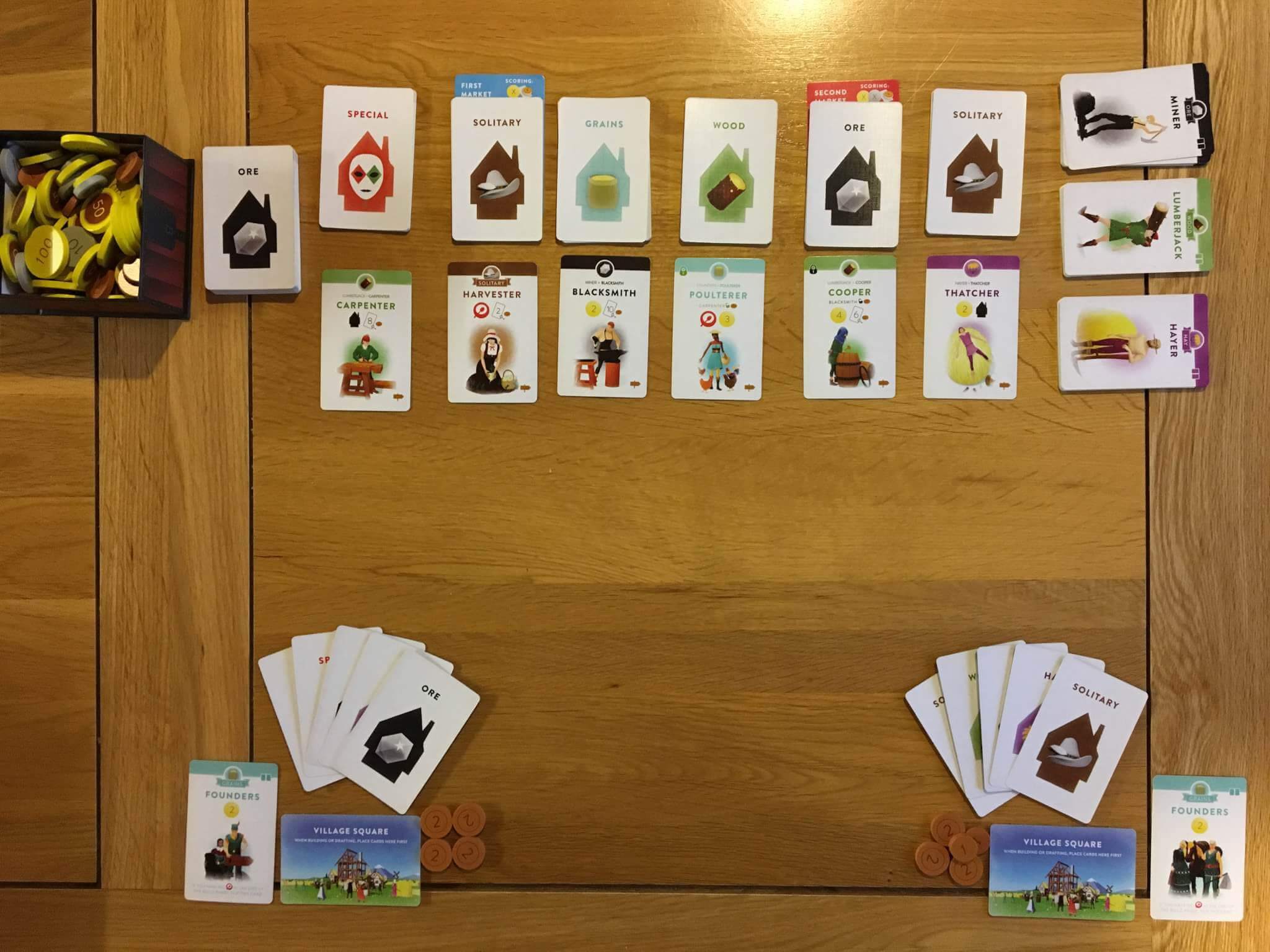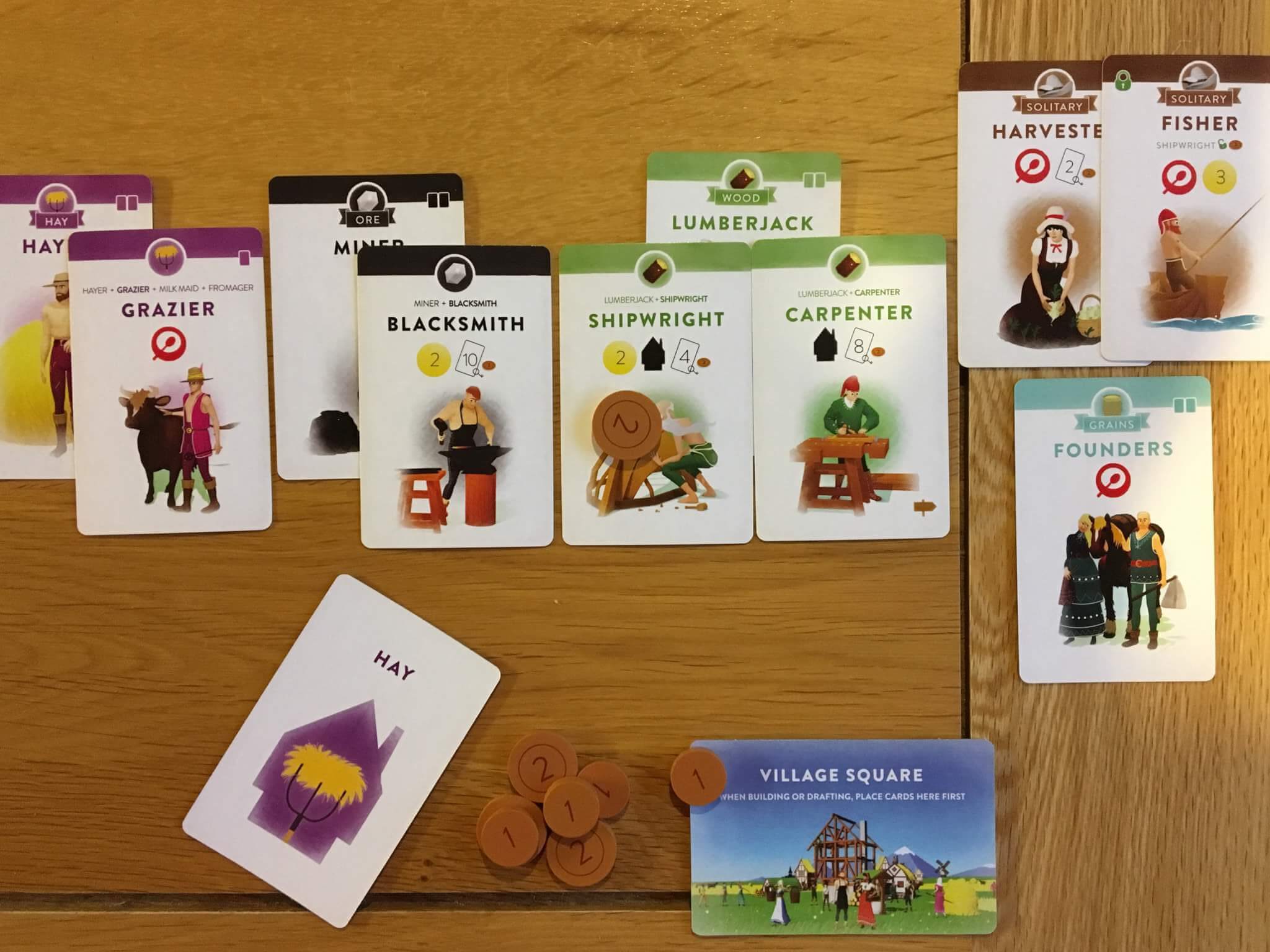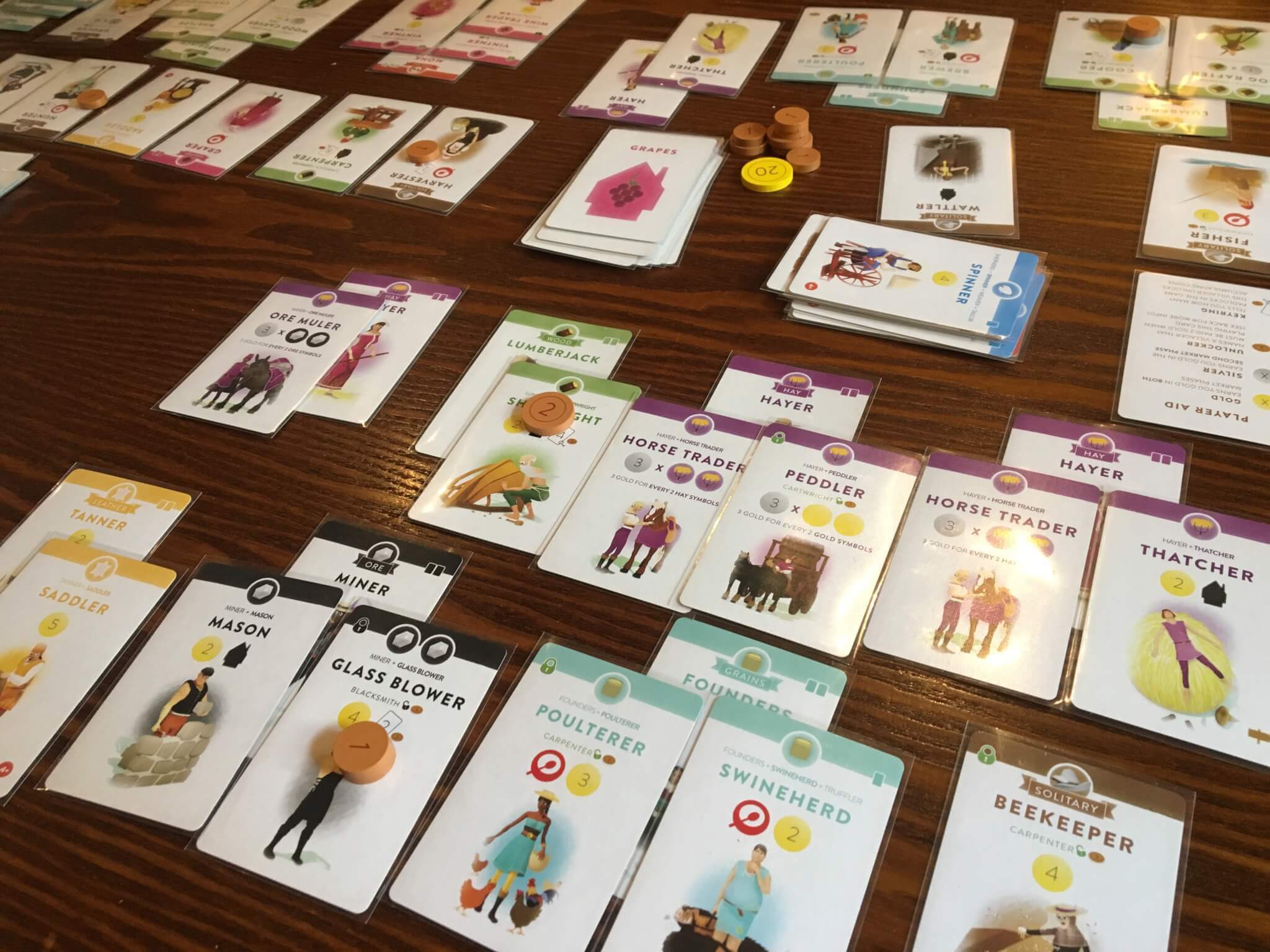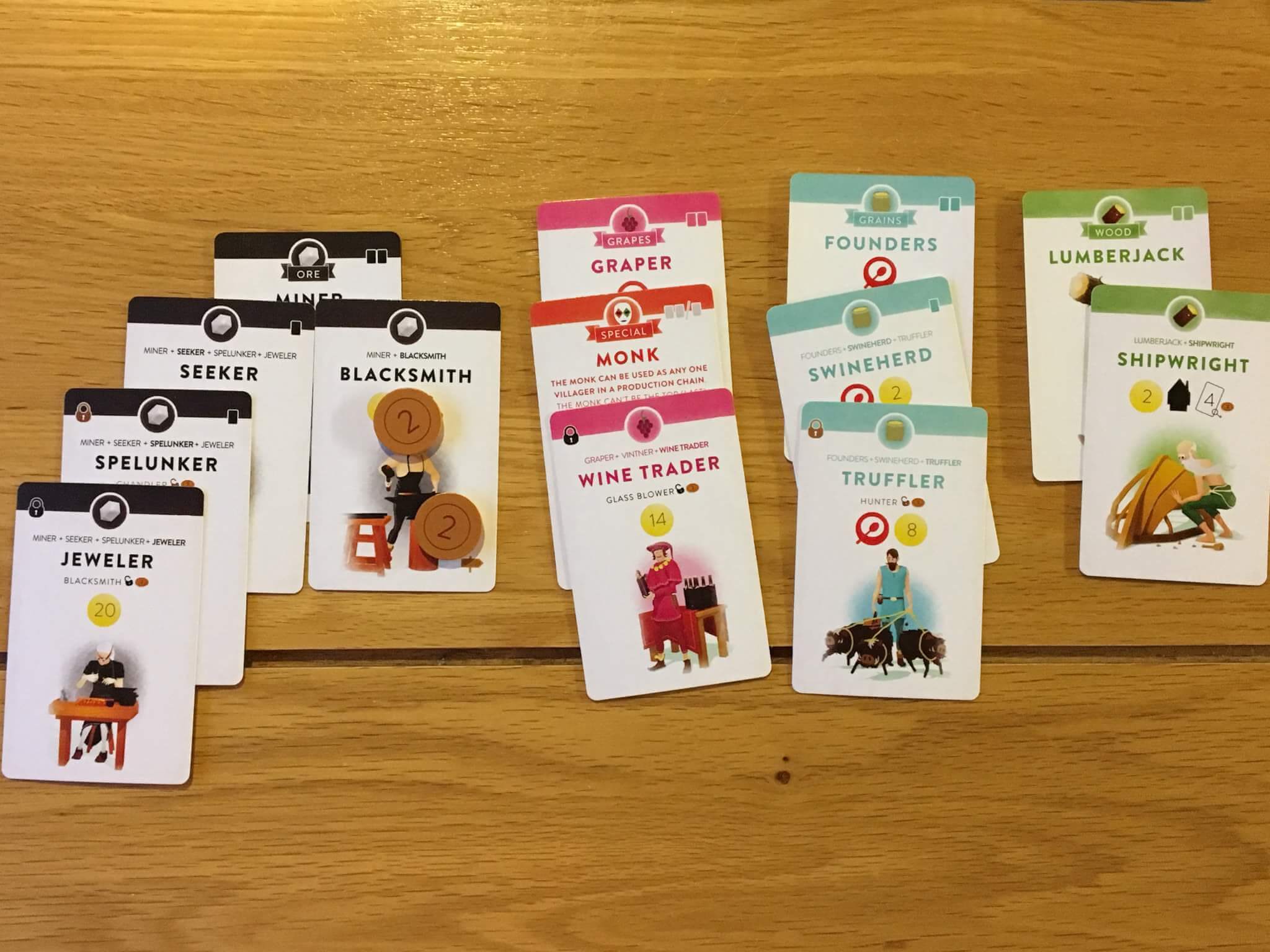What seems like an age ago now, I started hearing rumours about an understated tableau building game on Kickstarter that came with gorgeous pastel artwork and a fast, addictive play style. Now shipping and coming soon to retail, that game was Villagers, and it has just sold out at UKGE 2019 within a matter of hours.
Without jumping to conclusions, Villagers is the kind of card game that offers all things to all possible kinds of player. Villagers is fast and easy to set up, simple to teach and yet it features very deep gameplay that becomes more and more immersive as you play more of it.

Before I continue, I’d like to mention that the version of Villagers that I’ve been playing is the Kickstarter release, which includes several small expansions with wooden tokens (not pictured) and a few small decks of cards that add new features to the gameplay. I’ll focus mostly on the base game here, but you may notice some slight differences between this and the retail version.
The premise of Villagers is simple, as is the objective. The players are each acting as the founders of a village shortly after a great plague, and with luck and judgement, they hope to begin a new life. This entails attracting (drafting) villagers into your village based on their skills and those of the people you’ve already recruited. Ultimately, after two scoring rounds, the player with the most gold will win the game.

Every game of Villagers begins by forming The Road. This involves placing six starting villager cards face up in the centre of the table, with six decks of randomised cards in a similar row above them. Two of these decks will be placed onto the First and Second Market cards, which will trigger scoring events when those decks have been exhausted.
Each player is also given a village tile, a starting Founders card and four money tokens, as well as five cards that are dealt from the top of the reserve deck, which makes up the remainder of the cards. This reserve deck is sized differently depending upon the number of players, with additional sets of cards added at four or five players and some other minor tweaks made to accommodate two players.

With the setup done (which is aided hugely by the dividers that are provided in the game box) the game begins. The players will first perform a draft round in which they each take a turn to draw one villager from either The Road or one of the face down decks above it. When a villager is taken from The Road, a card from the top of the leftmost face down deck will be drawn to replace it.
Players continue taking turns to draft villagers in this way until they reach their limit. By default, this limit is two, but a number of cards in the game feature a bowl symbol that allows players to draft another card (up to a hard limit of five.) Similarly, many cards feature a house symbol, which allows more cards to be placed during the next phase, building.

During building, players add the cards that they drafted into their hand and may place them onto their tableau. There’s a tiny bit of complexity here in that some cards can be swapped out of your hand (back onto the leftmost facedown deck) in return for one of the three most basic villagers — the hayer, miner and lumberjack. None of these require a build action to place, but any card that is placed onto them (or onto any other card) costs a build action.
The way in which players increase their scoring potential is by creating chains of ever more valuable villagers, many of which have interlocking dependencies. Most villagers are dependant on the presence of other villagers, such as the Blacksmith, and so when such a villager is placed, the player putting it out will need to pay two gold — either to the bank or onto the blacksmith card of their choice (whichever village it is within.)

These dependencies are shown on each card as padlocks, with the unlocking villager clearly marked beside. Whilst these basic unlocking elements are one feature of gameplay to consider, a more important one is the way in which villagers chain. This is done in suits, but isn’t always as straightforward as it seems.
A hayer, for example, can chain into several other purple (hay) suited cards, but some of those end with a single card, whilst others allow two or three cards to the chained. As a general principle, a third or even fourth link villager will be worth considerably more gold than any first or second link in the chain. To compound this, basic villagers can only support one or two chains leading from them, so sometimes it will be necessary to start new chains even in the mid to late game.

There are a few other nuances to the basic structure. Some of the special cards allow players to take a benefit early or to change the rules somehow, whilst a few of the expansions add new features such as developments or saints and sinners that add either positive or negative effects to either you or the other players. There are relatively few complex rules, although it took me a while to get the hang of which deck I should be drawing cards from depending on the phase in question (the main deck or one of the decks above The Road.)
The real beauty of Villagers, aside from the speed at which it plays, its simplicity and how attractive it is, is that it gives the players full agency over their success or failure. Whilst it’s a cute looking game on the surface, Villagers is not a game that holds the players hands in terms of scoring. It is fiercely competitive and the score between first and last can be double quite easily.

The players will be incentivised to focus on several key strategies, including by focussing on the early “enabling” cards like the blacksmith and carpenter or to take high risk, high value cards that appear early in the hopes of creating something powerful later on. In between these strategies is aiming for consistent, relatively low value but common cards that will be guaranteed to score during both of the market phases.
With all these aspects brought together, Villagers is exactly what I want from a modern board or card game. It’s fun and attractive, with approachable rules that can be learned easily. The speed at which it plays and the addiction factor that it creates among those playing results in a real buzz around the table and a desire to play again. Add to all of this the fact that Villagers costs just twenty pounds in its base form and there’s almost no excuse not to add it to your collection.
Villagers is available for purchase now, including over on Amazon. You can find out more about the game over on the website of the developer, Sinister Fish.
